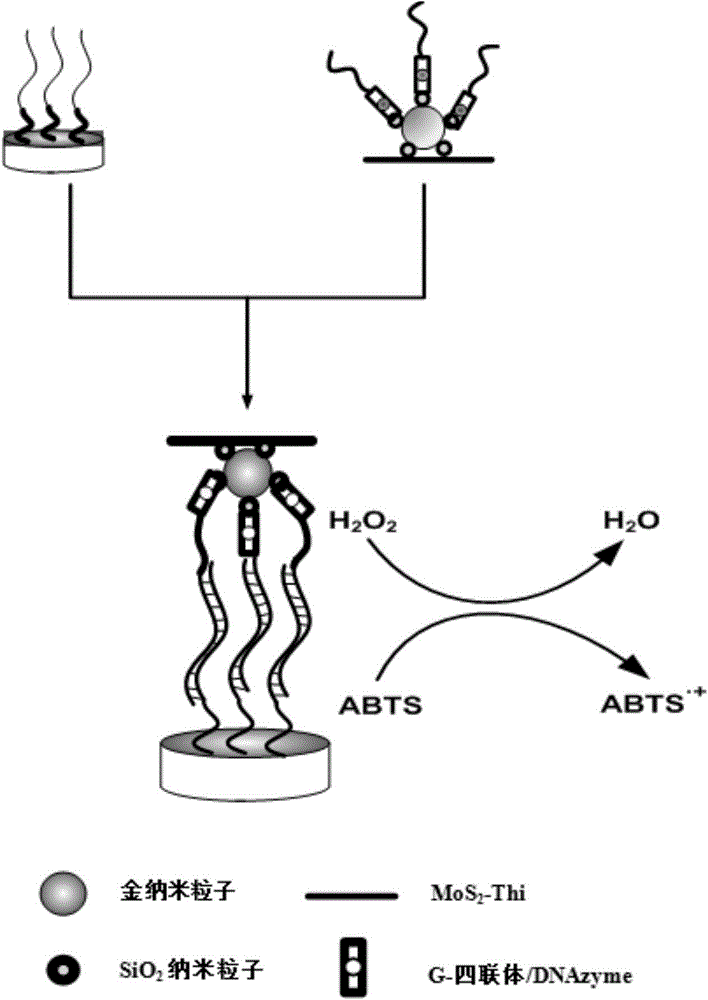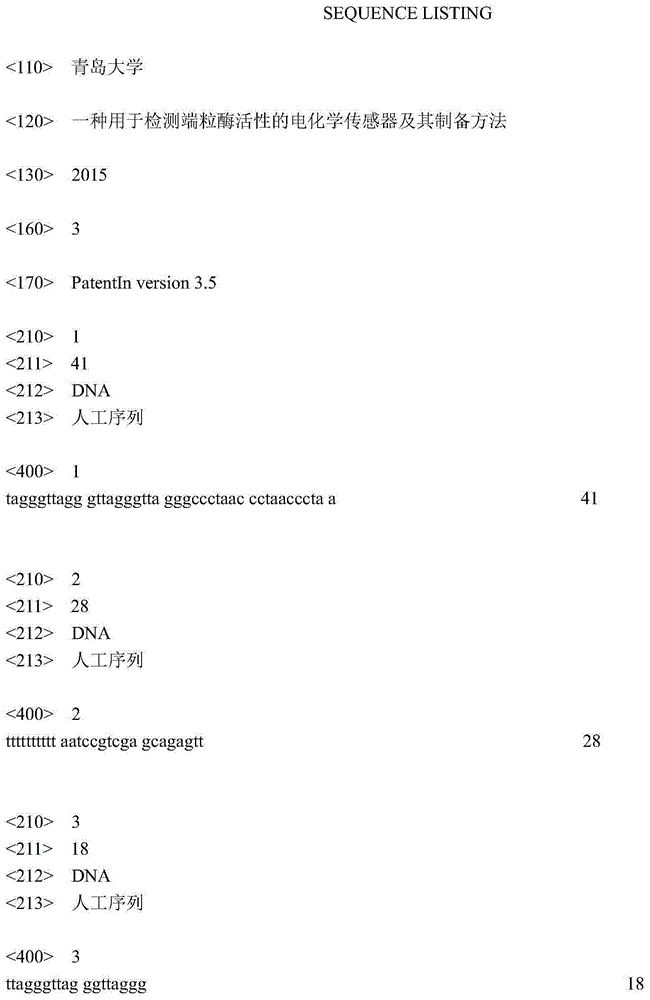Electrochemical sensor for detecting telomerase activity and method for manufacturing electrochemical sensor
An electrochemical and telomerase technology, applied in the field of electrochemical sensors and their preparation, can solve the problems of complex process, high telomerase concentration and low sensitivity, and achieve the effects of simple preparation method, mild reaction conditions and high sensitivity
- Summary
- Abstract
- Description
- Claims
- Application Information
AI Technical Summary
Problems solved by technology
Method used
Image
Examples
Embodiment 1
[0043] (1) Take 20 mg of molybdenum disulfide powder and dissolve it in 1 mL of organic solvent N-methyl-2-pyrrolidone. After ultrasonic stripping for 2-3 hours, let the dispersion stand for 15-20 minutes. Peel off the complete large particles to obtain a single-layer or several-layer molybdenum disulfide nanosheet dispersion, take 1mL dispersion and 1ml, 1mmol·mL -1 The Thi solution was mixed and sonicated for 3 h at room temperature, and the supernatant was discarded to obtain MoS 2 - Thi nanocomposite, poured into 1 mL of water; mix 99 mL of deionized water with 1 mL of 1% (W / V) HAuCl 4 Put the solution into a three-necked flask, seal it, heat it under reflux under vigorous stirring, and boil it at about 105°C, then quickly add 2.5mL of 1% (W / V) trisodium citrate solution, and the color of the solution changes from light yellow to dark in about 1min. Red, continue heating under reflux, stop heating after 20min, stir and cool at room temperature (23-25°C) to obtain Au parti...
Embodiment 2
[0050] Embodiment 2: the mensuration of actual sample
[0051] (1) The preparation of the electrochemical sensor and the drawing of the working curve are the same as in Example 1.
[0052] (2) Take a certain amount of Hela cell (human cervical cancer cell) samples, centrifuge (10000rpm, 5min), wash twice with 5mL PBS solution, add 200μL cell lysate (10mmol·L -1 , Tris–HCl at pH=7.5, 1mmol·L -1 MgCl 2 Solution, 1mmol·L -1 EGTA, 0.1mmol·L -1 Benzamidine, 5mmol·L-1 β-mercaptoethanol, 0.5% CHAPS, 10% glycerol), ice bath for 1h, centrifuge at 4°C (20000rpm, 15min), take the supernatant, and store it at -80°C; take 4μL of the supernatant and 6μL of DNA chain extension material buffer Liquid (20mmol·L -1 , Tris-HCl at pH=8.3, 1.5mmol·L -1 MgCl 2 Solution, 1mmol·L -1 EGTA, 63mmol·L -1 KCl solution, 0.05% Tween 20, 0.2mmol L -1 dATP, 0.2mmol·L -1 dGTP, 0.2mmol L -1 dTTP) mixed, and sucked and dropped onto the surface of the gold electrode with a pipette gun, and reacted at ...
PUM
 Login to View More
Login to View More Abstract
Description
Claims
Application Information
 Login to View More
Login to View More - R&D
- Intellectual Property
- Life Sciences
- Materials
- Tech Scout
- Unparalleled Data Quality
- Higher Quality Content
- 60% Fewer Hallucinations
Browse by: Latest US Patents, China's latest patents, Technical Efficacy Thesaurus, Application Domain, Technology Topic, Popular Technical Reports.
© 2025 PatSnap. All rights reserved.Legal|Privacy policy|Modern Slavery Act Transparency Statement|Sitemap|About US| Contact US: help@patsnap.com


